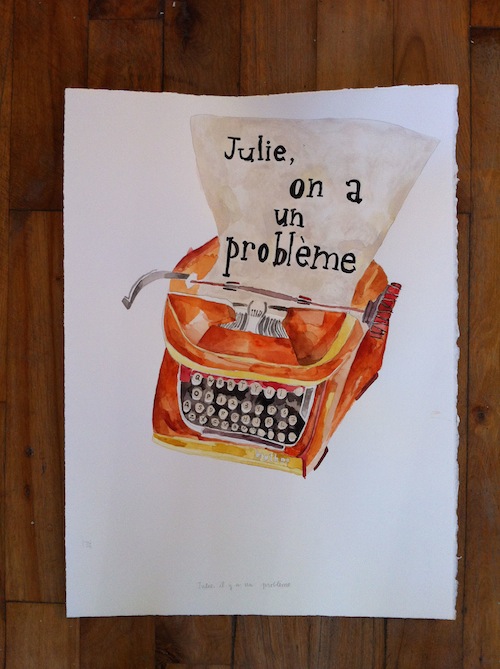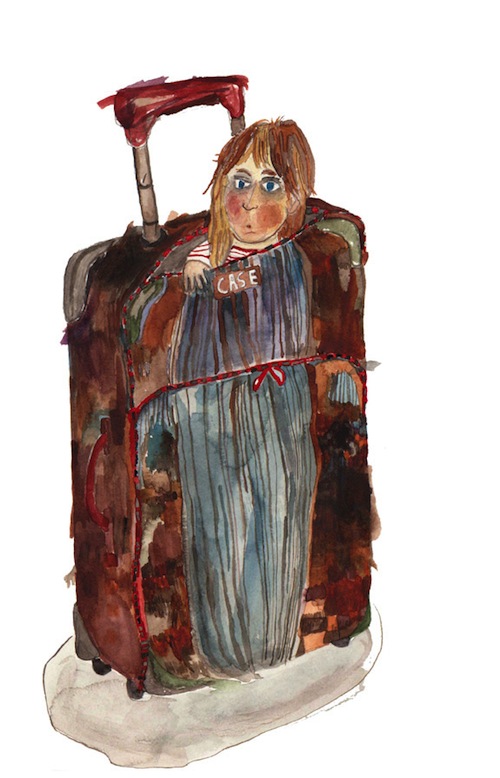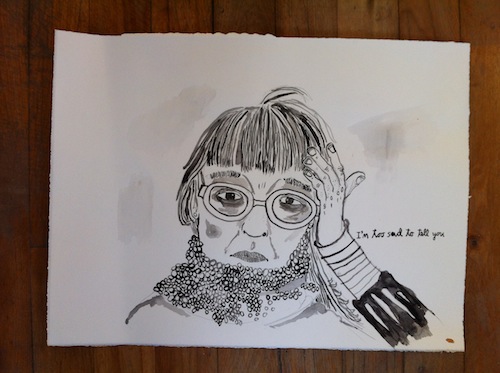French-Canadian artist Julie Lequin consciously blurs personal history and fictionalized worlds in her videos, performances, drawings, and writings, creating new narratives in the process. Lequin’s real-life events become part of an ongoing, first-person storyline that, told humorously and from an unconsciously self-conscious point-of-view, makes the viewer privy to the steps of her creative process.
Lequin has completed six residencies (and counting) in Europe and the United States, including Art Omi (Ghent, NY), Macdowell Colony (New Hampshire), Yaddo, (Saratoga Springs, NY), Cow House Studio (Ireland), and the Kimmel Harding Nelson Center Residency (southeastern Nebraska). Many of the odd, linguistic experiences she has while traveling make their way into her artwork.
In 2010, Lequin completed Les Récollets Artist Residency, run by Quebec Art Council though located in the middle of Paris. It’s supposed to be an artist’s dream come true.
“Who doesn’t want to get paid to be in the studio and be in Paris?,” Lequin says matter-of-factly.
And it’s true. What artist could resist the chance to work in the same city that inspired the likes of, to name just a few, Gustave Courbet, Suzanne Valadon, and Marcel DuChamp?
In Paris, Lequin continued working on her project Top 30, which gleans memories from the past 30 years of her life. Each chapter is presented as a three-channel video. Lequin’s watercolor drawings of the houses she’s lived in, and other memorabilia, appear in the videos and also, sometimes, alongside them. “The drawings in Top 30 were ‘props’ but they are always their own entity, too. I think when you see them displayed you can perhaps create your own narrative. In the video they work more as illustrations,” says Lequin.
Top 30 began in 2008, when the artist was “living in a suitcase,” traveling and moving between artist residences. The project has since been presented at 2nd Cannons in Los Angeles (2009), and the Crisp-Ellert Art Museum in St. Augustine, Florida (2011).
“I was hoping to continue filming for the Top 30 project [in Paris], which required me to find, coach, and then film young girls singing a pop song,” says Lequin. “I had worked on the same project in L.A. and Montreal, and it was pretty easy to recruit people, especially in L.A. where everybody secretly wished to be a star, I think.”
Even though Lequin speaks French (albeit with a different accent), the process of finding people in Paris to be in her videos proved difficult.

Julie Lequin. “En résidence,” 2012. Watercolor and pencil on paper, 13 x 10 in. Courtesy the artist.
“It was impossible to find kids to be in my video,” she says. “Parents and teachers were suspicious and reluctant. No one was answering my ads on the bulletin board. I was basically on my own in a residency-jail-made-out-of-gold.”
In addition to Parisians’ disinterest in the project, the residency itself felt isolating for Lequin, who had been used to working around friends and, often times, collaboratively with other artists. In Paris, she was given her own apartment, which she enjoyed the first three weeks of her stay. Soon, though, she began to miss talking to people, cooking with friends, and visiting their places for dinner. It became difficult for her to stay motivated, and meeting locals had already proven near impossible. Lequin discovered that location plays an important role in a collaborative project like Top 30.
“This residency made me realize that I’m at my best when I can rely only on my skills and my own performance in front of the camera,” she says. “I also discovered that I’m more productive when I am surrounded by people I love and can exchange with. I don’t have to see them everyday, but it’s nice to know there’s always someone I can call if I have a freak out.”

Julie Lequin. “Holding a Sign,” 2012. Watercolor and pencil on paper, 13 x 10 in. Courtesy the artist.
Now back in Montréal, Lequin is newly engaged but not rushing to make wedding preparations. “I am teaching two sculpture classes and preparing for my solo show in Winnipeg,” she explains. “I also do cross country skiing.” When Lequin isn’t doing all of these things, she’s collaborating with Montréal artist Zipertatou on a video project involving puppets; Lequin will play all of the characters.
For the artists featured earlier in this blog series—Peregrine Honig and Christopher Meerdo—location acted as a catalyst for change. Honig and Meerdo traveled to their respective residencies in Argentina and Iceland with ideas for bodies of work that did not resemble what they left with. Honig had originally pitched a residency project around the concept of beauty queens with residual childhood diseases, whereas Meerdo thought he would make work about Iceland as a safe haven for Wikileakers. But the cultural climates of their residencies were in fact pivots, turning them in different directions and, in turn, affecting their practices overall. Honig’s work acquired new layers and cross-cultural meaning, and Meerdo ended up focusing on the Icelandic landscape while also finding time to decompress post-graduate school. Yet Lequin’s project stayed the same and the location had an adverse affect on Top 30.
Even when artists can speak the language of people around them, important nuances might still get lost in translation. Sometimes, staying close to home is a good thing.
Julie Lequin (b. 1979, Laval, Quebec) earned her BFA from Concordia University (Montreal, PQ), and MFA from the Art Center College of Design (Pasadena, CA). She has exhibited at the Santa Barbara Contemporary Arts Forum (California), La Centrale Powerhouse (Montreal), and White Columns, and Horton & Liu Gallery (New York City). Her first book and DVD project was published in 2007 by 2nd Cannons Publications. In addition to her many residencies, Lequin is recipient of a California Community Foundation fellowship. Currently, she is based in Quebec.
Alicia Eler is Blogger-in-Residence through February 28.





